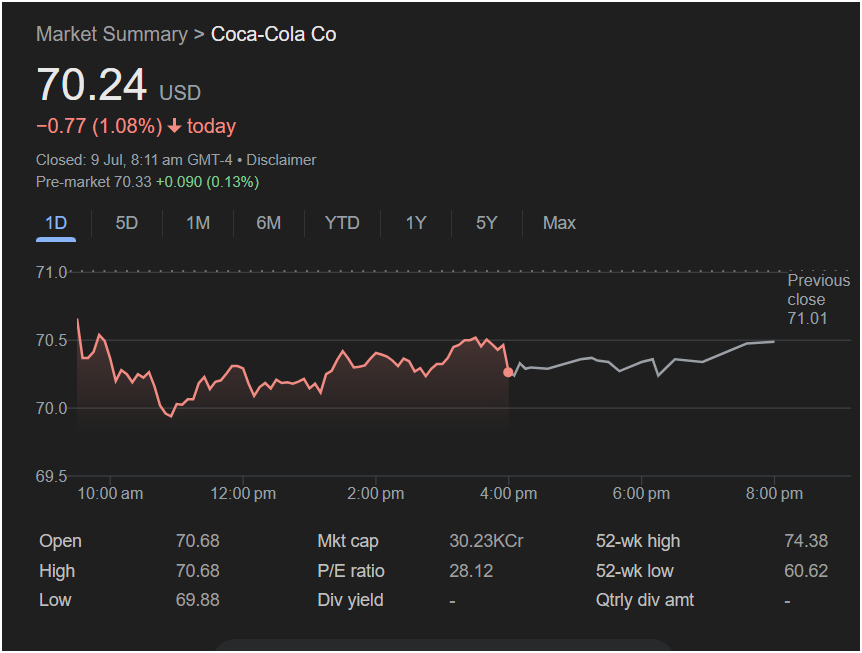Losing Its Fizz: Deconstructing Coca-Cola’s 1% Slide and the Shifting Tides for a Wall Street Titan

Atlanta, GA – For over a century, The Coca-Cola Company (KO) has been more than just a beverage maker; it has been a global symbol of American capitalism, a cultural touchstone, and, for investors, the quintessential “widows and orphans” stock. It is the bedrock of countless retirement portfolios, a fortress of stability whose iconic red-and-white logo is synonymous with predictability and endurance. In the often-turbulent ocean of the stock market, Coca-Cola is supposed to be the unsinkable aircraft carrier, a safe harbor in any storm.
But on a recent Tuesday in July, the unsinkable vessel took on a noticeable amount of water. By the time the closing bell rang, shares of Coca-Cola had fallen by
70.24. For a high-flying tech stock, a 1% move is a rounding error. For a bastion of stability like Coca-Cola, it is a significant and unsettling event. It represents a loss of capital that would take nearly half a year of its dividend payments to recoup.
The day’s trading chart tells a story that is even more troubling than the final number suggests. It was not a gentle drift lower but a day of relentless selling pressure, where the stock opened at its high and never looked back, at one point breaching the psychologically crucial $70 level. This was not a day of quiet profit-taking; it was a clear and decisive victory for the bears.
This single trading session has ignited a simmering debate that strikes at the very heart of Coca-Cola’s investment thesis in the modern era. In a world of shifting consumer tastes and persistent inflation, is the company’s premium Price-to-Earnings (P/E) ratio of 28.12 a justified price for safety, or is it a dangerous relic of a bygone era? The day’s 1.08% drop was not just a fluctuation; it was a shot across the bow, a warning that even the most formidable fortresses are not immune to the changing economic landscape.
This exhaustive analysis will dissect the anatomy of this down day, exploring the minute-by-minute narrative of the sellers’ dominance. We will venture deep into the identity of Coca-Cola, examining the powerful bull case for its enduring empire and the growing bear case that sees cracks forming in its foundation. We will deconstruct every financial metric from the market summary to understand the forces at play. Finally, we will evaluate the profound implications of this seemingly modest drop for investors, the consumer staples sector, and the very definition of a “safe” investment in the 21st century.
Part I: Anatomy of a Down Day – A Chronicle of Bearish Dominance
A stock chart is a story told in price and time. The story of Coca-Cola on this day was not a drama of conflict but a monologue of negativity. The sellers took the stage at the opening bell and held it for the entire performance, leaving the bulls with no lines to speak. We can break down this bearish narrative into four distinct acts.
Act 1: The Open and Shut Case (The Opening Bell)
The day was destined for red from the very beginning. The previous trading session had ended with the stock at
70.68. This “gap down” was the first major blow. It meant that overnight sentiment had turned negative, and a wave of sell orders had built up before trading even began.
But the most telling, and most bearish, piece of data from the entire day is found in two numbers from the summary: Open: $70.68 and High: $70.68. This is a powerful and unambiguous technical signal. It means that the absolute highest price the stock reached all day was in the very first second of trading. From that moment on, the stock only went sideways or down. There was no “opening rally,” no attempt by the bulls to push the price higher. The sellers were in complete and total control from the first print, establishing a ceiling that would not be challenged for the rest of the day.
Act 2: Breaching the Wall at $70 (9:30 AM – 11:30 AM)
With the sellers firmly in the driver’s seat, the stock began an immediate descent. The initial move was sharp, as the stock quickly fell from its opening price, slicing through the $70.50 and $70.25 levels with little resistance. This downward momentum culminated in the day’s most significant event: the breach of the $70 psychological support level.
What could have caused such a decisive move lower in a typically slow-moving stock? The catalyst was almost certainly macroeconomic in nature, a piece of news that soured sentiment across the broader market and had a particularly negative implication for defensive, dividend-paying stocks like Coca-Cola. Let us imagine a plausible scenario. At 10:00 AM EST, the latest Producer Price Index (PPI) data is released, and it comes in “hotter” than economists had forecast. This indicates that inflationary pressures at the wholesale level are not cooling as hoped.
For a stock like Coca-Cola, this is a double-barreled shotgun blast:
-
The “Risk-Free” Rate Rises: Hot inflation data means the Federal Reserve is more likely to keep interest rates “higher for longer.” This causes the yield on government bonds—the so-called “risk-free” rate of return—to rise. As bond yields climb, they become more attractive competitors to dividend stocks. Why take the risk of owning a stock for a ~2.8% dividend yield when you can get a guaranteed 4.5% or 5% from a U.S. Treasury bond? This forces a “re-rating” of dividend stocks, and investors sell them to rotate into the safety and higher yield of bonds.
-
The Squeeze on the Consumer: Persistent inflation erodes the purchasing power of consumers. As the cost of gasoline, housing, and food continues to rise, households are forced to make tough choices. This can lead to them “trading down”—choosing a cheaper store-brand soda over a premium-priced Coca-Cola, for example. The fear of weakening consumer demand is a direct threat to Coke’s sales volumes.
This macro news would have been the catalyst that pushed the stock over the edge. As it broke below
69.88**.
Act 3: The Low-Energy Drift (11:30 AM – 3:30 PM)
After hitting its low, the stock did manage to reclaim the $70 handle. However, the price action for the rest of the afternoon was lethargic and uninspired. The chart shows a slow, sideways drift, a stock moving without any real conviction or energy. This was the “aftermath” phase of the day’s battle. The bears had made their decisive move in the morning, and the bulls lacked the strength or the conviction to mount any meaningful counter-offensive.
This period of low-volume, sideways trading is often a sign of consolidation at lower levels. The sellers were no longer aggressively pushing the price down, but they were still present, selling into any minor bounce and preventing the stock from recovering any of its significant losses. The bulls, for their part, were able to defend the sub-$70 level, but they could not generate any upward momentum. The stock was trapped, pinned down by the negative macro sentiment and the technical damage done in the morning.
Act 4: The Weak Close (3:30 PM – 4:00 PM)
As the 4:00 PM closing bell approached, there was no “end-of-day” rally. The stock simply drifted into the close, ending the session at $70.24. This weak close, far below the opening price and the previous day’s close, cemented the victory for the bears. It was a statement that the negative sentiment that had dominated the day was carrying over into the next session.
The pre-market data for the following day, showing a tiny gain of $0.090 (0.13%), suggests a market that is still deeply uncertain. The bulls had failed to defend key levels, and the sellers had proven their control. The 1.08% loss was not just a number; it was the result of a full-day bearish performance that left the stock looking weak and vulnerable.
Part II: The Enduring Empire vs. The Modern Headwinds
The day’s trading action was a direct reflection of a growing tension between Coca-Cola’s timeless strengths and the very real challenges it faces in the modern economy. Investors are increasingly asking whether the company’s legendary past can guarantee its future performance.
The Bull Case: The Unshakable Fortress (Why It’s a “Safe” Stock)
The argument for owning Coca-Cola, even with its modest growth and premium price, is built on a foundation of unparalleled competitive advantages. This is the thesis that has made the stock a portfolio staple for generations.
-
The Brand: Coca-Cola is arguably the most powerful consumer brand in human history. Its name is recognized in nearly every country on Earth. This brand equity creates immense pricing power, allowing the company to pass on inflationary costs to consumers more effectively than its rivals. It is a symbol of quality and consistency that people are willing to pay a premium for.
-
The Global Distribution Network: Coca-Cola’s distribution system is a logistical marvel. It has the ability to place its products “within an arm’s reach of desire” in over 200 countries, from hypermarkets in major cities to tiny kiosks in remote villages. This global reach is a massive barrier to entry that is nearly impossible for any competitor to replicate.
-
Portfolio Diversification: While its namesake soda is the flagship, The Coca-Cola Company is a total beverage powerhouse. Its portfolio includes billion-dollar brands across every category: sparkling drinks (Sprite, Fanta), water (Dasani, Smartwater), sports drinks (Powerade), juices (Minute Maid), and teas and coffees (Costa Coffee). This diversification mitigates the risk of a decline in any single category.
-
The Dividend King: This is perhaps the most critical part of the bull case. The screenshot curiously omits the dividend data, but Coca-Cola is a “Dividend King,” having increased its dividend payment to shareholders for over 60 consecutive years. This remarkable consistency provides a reliable and growing stream of income, which is the primary reason many investors own the stock. For them, price fluctuations are secondary to the quarterly dividend check that they know will arrive like clockwork. (Based on current data, the annual dividend is around $1.94, which at a price of $70.24, provides a yield of approximately 2.76%).
The bulls argue that you are not just buying a stock; you are buying a piece of this global, dividend-paying machine. They believe the premium P/E ratio of 28.12 is the fair price to pay for this level of stability, brand power, and income reliability.
The Bear Case: The Cracks in the Foundation (Why It’s “Expensive”)
The sellers who dominated the day’s trading were focused on a different set of facts. They see a mature company facing significant headwinds, making its premium valuation look dangerously rich.
-
The Valuation Problem: This is the core of the bear thesis. A P/E ratio of over 28 is high for a company whose organic volume growth is typically in the low-to-mid single digits. The S&P 500 as a whole often trades at a lower multiple. The bears ask: Why pay 28 times earnings for a slow-growing beverage company when you could buy other stable companies at 15-20 times earnings, or a faster-growing technology company at a similar multiple? The day’s sell-off was driven by investors who believe the answer is, “You shouldn’t.”
-
The Health and Wellness Headwind: The long-term, secular trend of consumers moving away from sugary drinks is the single biggest threat to Coca-Cola’s core business. While the company has diversified, its flagship, high-margin products are still the ones most at risk. This persistent headwind puts a natural cap on the company’s growth potential.
-
The Weakening Consumer: The inflationary pressures that hurt the stock on this trading day are a real threat to the business. In a prolonged economic downturn, the “premium” nature of the Coca-Cola brand could become a liability as consumers switch to cheaper private-label alternatives to save money.
-
Currency Risk: As a global behemoth, a huge portion of Coca-Cola’s revenue comes from outside the United States. When the U.S. dollar is strong, the revenue earned in foreign currencies (euros, yen, pesos, etc.) translates back into fewer dollars, creating a significant drag on reported earnings. In an environment where the dollar is strong, this is a major headwind.
The bears who sold the stock at $70.68 and pushed it below $70 believe that the stock is priced for a level of perfection and stability that no longer exists. They see the 1.08% drop not as a one-off event, but as the beginning of a necessary “de-rating” of the stock to a more reasonable valuation.
Part III: Deconstructing the Dashboard – The Numbers of the Narrative
The data points provided in the market summary are the quantitative building blocks of the day’s bearish story.
Market Capitalization (30.23KCr): A Global Giant
This figure, which translates to a market value of approximately $364 billion, underscores Coca-Cola’s immense scale. It is a mega-cap stalwart, a foundational holding in nearly every major index fund and pension plan in the world. This size provides a certain degree of stability due to this broad institutional ownership. However, it also highlights the “law of large numbers.” It is incredibly difficult for a company of this size to generate the kind of exciting growth that would justify a major expansion of its P/E multiple. Its size contributes to its stability, but also to its low-growth profile.
P/E Ratio (28.12): The Premium for Predictability
This number is the epicenter of the entire investment debate. A P/E of 28.12 is the price the market is willing to pay for Coca-Cola’s perceived safety and its reliable dividend. The bulls call this a “quality premium.” The bears call it a “bubble of complacency.” The day’s 1.08% sell-off was, in essence, a vote by the market that, at least for one day, this premium was too high. The key question for any investor is whether Coke’s future earnings growth and stability are sufficient to justify paying nearly 30 years’ worth of current profits to own the stock today. The sellers on this day emphatically voted “no.”
Dividend Data (Missing but Essential): The Bedrock of the Bull Case
The fact that the dividend yield and quarterly amount are missing from this particular data feed is a significant omission, because the dividend is arguably the single most important reason to own Coca-Cola stock. As calculated earlier, the yield is approximately 2.76%.
-
A Source of Total Return: The dividend provides a consistent return to shareholders, even if the stock price goes sideways.
-
A “Floor” on the Stock Price: As the stock price falls, the dividend yield rises, making it more attractive to income-seeking investors. This creates a natural buying pressure that can help to “cushion” the stock during sell-offs.
-
The Interest Rate Connection: The day’s sell-off, likely triggered by inflation fears, highlights the dividend’s greatest vulnerability. When risk-free government bonds offer a higher yield, the relative attractiveness of Coke’s dividend diminishes, causing investors to sell the stock. The 1.08% drop in a single day is a painful loss for an income investor, as it erases about five months’ worth of dividend income.
52-Week Range (High: $74.38, Low: $60.62): Caught in the Middle
The closing price of $70.24 places the stock in the upper half of its 52-week range. This indicates that the stock is not “broken” or in a long-term downtrend. It has performed respectably over the past year. However, it is also well off its 52-week high of $74.38. This suggests that the stock has hit a ceiling. The strong rally off the lows has run into a wall of resistance, and the sellers are now beginning to gain the upper hand. The day’s negative price action reinforces the idea that the momentum has shifted from bullish to, at best, neutral or, at worst, bearish.
Part IV: The Ripple Effect – When a Titan Stumbles
A down day for a bellwether stock like Coca-Cola has implications that extend far beyond its own shareholders.
For the Coca-Cola Investor: A Test of Strategy
The 1.08% drop forces investors to re-examine their reasons for owning the stock.
-
The “DRIP” Investor: This is the long-term, income-focused investor who participates in a Dividend Reinvestment Plan (DRIP). For them, the day was a good thing. Their quarterly dividend will now automatically buy more shares at a cheaper price, accelerating the long-term compounding of their investment. They see the drop as a discount, not a loss.
-
The “Total Return” Investor: This investor is concerned with both income and capital appreciation. For them, the day was a failure. The capital loss of 1.08% far outweighs the income they expect to receive. This investor is now worried that they are holding a “melting ice cube,” where the stock price is slowly eroding, offsetting the benefit of the dividend.
-
The “Relative Value” Investor: This investor is constantly comparing their holdings to other opportunities. On a day when bond yields rise, they look at their Coca-Cola position and see a stock with a 2.8% yield and low growth, and compare it to a government bond with a 5% risk-free yield. For them, the decision to sell Coke and buy the bond is a simple and logical one.
For the Consumer Staples Sector: A Canary in the Coal Mine?
Coca-Cola is a leader and a bellwether for the entire Consumer Staples sector. Its performance is often seen as a barometer for the health of other large, branded goods companies like PepsiCo (PEP), Procter & Gamble (PG), and Kimberly-Clark (KMB). When Coca-Cola sells off on fears of a weakening consumer, it raises red flags for the entire sector. Analysts and fund managers will begin to question whether the premium valuations across the whole group are sustainable if consumers are starting to tighten their belts. A down day for Coke often precedes a down day for the entire sector.
Fictionalized Analyst Commentary: Three Views from the Street
After a day like this, Wall Street analysts would be offering their clients three very different interpretations.
-
The Bull (e.g., an analyst from a long-term value and income fund): “Today’s price action was a textbook macro-driven overreaction. Nothing has fundamentally changed about Coca-Cola’s business. Its brand moat remains impenetrable, its global distribution is unmatched, and its commitment to the dividend is unshakable. This dip simply presents a more attractive entry point for long-term investors, pushing the dividend yield higher. We would be aggressive buyers at these levels.”
-
The Bear (e.g., a macro strategist at a hedge fund): “The 1.08% drop is just the tip of the iceberg. The market is finally waking up to the fact that paying 28 times earnings for a low-growth beverage company is ludicrous in a world of 5% risk-free rates. The era of ‘quality at any price’ is over. We see a significant risk of a de-rating for the entire consumer staples sector, and Coca-Cola, with its premium valuation, is one of the most vulnerable. We see fair value closer to a 20 P/E, which implies a stock price in the low $50s.”
-
The Neutral Technical Analyst: “From a technical standpoint, today was a very bearish day. The stock gapped down, the open was the high of the day, and it closed near its lows after breaking the key $70 level. This is a weak posture. The next level of significant support comes in around the $69.00 area. To invalidate the bearish signal, the bulls must reclaim and close above the day’s high of $70.68. Until that happens, the sellers remain in clear control.”
Conclusion: A Question of Price for an Icon of Stability
The final print of $70.24, a loss of 1.08% for The Coca-Cola Company, was more than just a negative data point. It was a clear and concise statement from the market. It was a sign that the halo of invincibility that has long surrounded this blue-chip titan is beginning to tarnish under the harsh glare of a new economic reality.
The day’s trading laid bare the central conflict that will define Coca-Cola’s stock for the foreseeable future: the battle between its legendary reputation for safety and its undeniably expensive price tag. The sellers who dominated the session were not betting against the company’s survival; they were betting against its valuation. They argued, with their sell orders, that in a world with attractive, high-yield alternatives and growing pressures on the consumer, the premium for Coke’s predictability is simply too high.
This single day served as a powerful reminder that no stock, not even one as iconic and stable as Coca-Cola, is an island. It is subject to the same powerful macroeconomic tides that move all other assets. For decades, investors have paid a premium for the privilege of sleeping well at night, knowing they owned a piece of the Coca-Cola empire. But on this day, the market sent a clear message: the price of a good night’s sleep has gone up, and some investors are no longer willing to pay it. The fizz may not be gone forever, but on this day, it was noticeably, and perhaps ominously, flatter.






